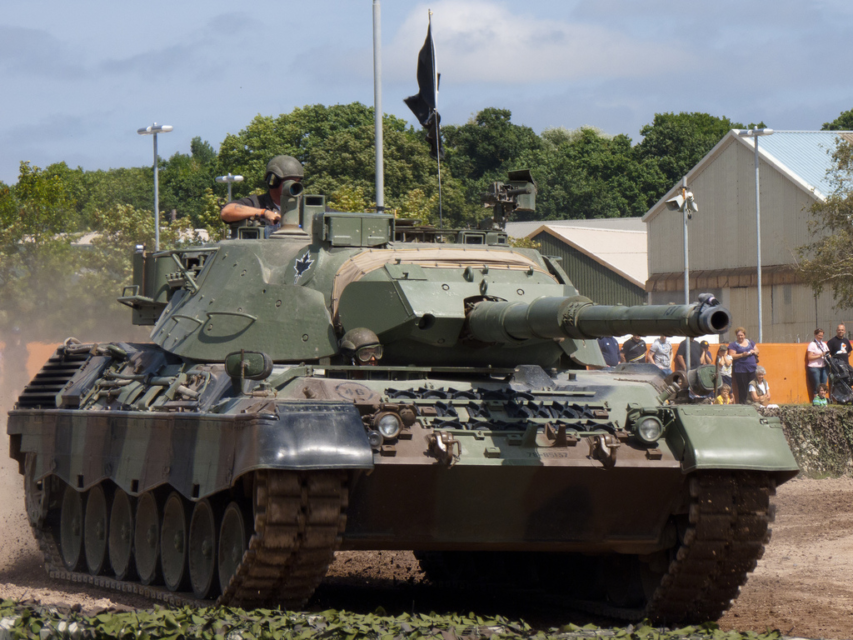The Great War
Published on 25 May 2018In our first episode filmed on the former Gallipoli battlefields, Indy and our guide Can Balcioglu explore the naval campaign that preceded the landings at Gallipoli in early 1915.
May 28, 2018
Naval Operations In The Dardanelles Campaign 1915 I THE GREAT WAR On The Road
Leopard tanks in Afghanistan – “When the legend becomes fact, print the legend”
There’s a story that’s been told for more than a decade and — given the Canadian government’s legendary unwillingness to spend money on the military — widely believed. David Pugliese does his best to debunk it here:

Canadian Leopard 1A3 (Leopard C1) at the Bovington Tank Museum.
Photo by Chris Parfeniuk, via Flickr.
As stories go it’s a pretty good one.
The Canadian Army was up against a tough enemy – the Taliban – in Afghanistan. Commanders called for Leopard tanks to join the battle but those armored vehicles had been mothballed and made into monuments.
So the ever resourceful Canadian Army crews jumped in the Leopard tanks mounted on concrete pads outside bases as monuments and drove them off those platforms, making sure they were shipped to their comrades in Afghanistan.
This myth has been around since 2007 and has once again resurfaced in a new book by retired Maj.-Gen. David Fraser about Operation Medusa.
Fraser also repeated the story in a recent CBC interview with Anna-Maria Tremonti, noting that he knew of at least one Leopard tank pulled off its concrete pad and brought back to serviceability and then shipped to Afghanistan.
In the 2008 book Kandahar Tour by Lee Windsor, David Charters and Brent Wilson the story gets even better. The tanks were driven off the concrete pads and then sent to Afghanistan, according to those authors.
A similar claim is made at the museum devoted to telling the story of the “Essex Regiment (Tank).” On its website the museum claims multiple numbers of Canadian Leopard tanks were taken from monuments (“A mad scramble to retrieve tanks from monuments and prepare them for war,” it claims).
Again, a great story.
But the Canadian Army says it never happened.
The Army points out that Leopard tanks, positioned on the concrete pads as monuments, had already been demilitarized so no one was driving them anywhere.
So what did happen?
Middle East: Palmyra Today – Afterword – Extra History
Extra Credits
Published on 31 Oct 2015Learn about Odenathus, King of Palmyra: http://bit.ly/1GDsDvz
____________Palmyra is an embodiment of our shared past, but right now it’s under the control of ISIS. They have destroyed the antiquities that remind us of our shared past. We would like to take a moment to honor Dr. Khaled al-Assad, the museum director who gave his life rather than reveal the locations of more Palmyrene relics for ISIS to destroy.
QotD: Correcting mistakes in private and public enterprises
… government cannot do just one thing, and some of the repercussions of what it chooses to do will be, as it were, mistakes in the perspective of the public even if the initial action were not. But the public’s dissatisfaction with these adverse outcomes can make itself known only via the politically charged process of complaint to authorities, petition for redress of grievance, lobbying, payoffs to public officials, and all the rest of the endlessly complex apparatus for the operation of the government’s political and bureaucratic setup. One is lucky to get any constructive response at all from the government, whose effective control is apt to be in the hands of entrenched politicians, bureaucrats, and private-sector cronies in the various iron triangles that pervade the state at large. If one does succeed in getting a constructive response, it is likely to come forth only after years of expensive and time-consuming delays.
This lack of an effective feedback-incentive mechanism is among the greatest flaws of all government activities. Markets, in contrast, are certainly not perfect relative to the model criteria economists have devised to evaluate them, but they are undoubtedly superior in the operation of their feedback information and response to mistakes. To remove an activity from the market and place in under government control is to ensure that henceforth mistakes, whether they arise from bad judgement, corruption, or ignorance, will not elicit a proper or timely response. In the government realm, mistakes and the slow, counter-productive responses, like doomed lovers, sink together slowly in the quicksand of bad actions being made ever worse by ill-fated reactions.
Robert Higgs, “Dealing with Mistakes: Government Action versus Private Action”, The Beacon, 2016-08-17.



